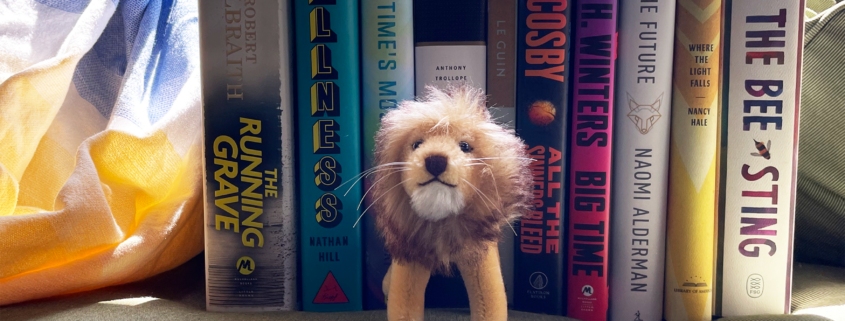Summer Reading 2024
We hope you have a terrific summer, with a little downtime here and there.
Big Time
by Ben H. Winters
If you’re a long-time reader of our reviews, Susan is a big fan of Ben Winters’ The Last Policeman trilogy. (And not just because there’s a scene with a BD Pyxis in one of the books.) Big Time is a thriller with a sci-fi twist, with a hero, Grace Berney, who’s a mid-level claim examiner at the FDA living with her teen-aged daughter and her aging mom. Grace is asked to help identify an unconscious young woman through the registration of a specialized port installed in her chest. Like any informational search in the age of infinite databases, she ends up down a wormhole and begins to suspect a highly unusual medical procedure may be happening off-label. Racing against a particularly ruthless assassin, she struggles to find the answers, before time (literally) runs out. The book’s a delightful thriller, perfect for fans of Killing Eve and Breaking Bad. It’s a particularly fun premise to have an ordinary desk jockey from the FDA turn action hero.
The Bee Sting
by Paul Murray
The Bee Sting is a heartbreaker of a book. It’s the story of the Barnes family told from different family member perspectives as the action moves forward. It’s like watching a horror movie and hoping the actors don’t go into that room or open that door. A tragic Irish tale, with shades of climate change blending with the global financial crash of 2008. The writing is as propulsive as the action, although the characters are looking backwards, gradually spilling all the family/neighborhood secrets. Reads like a thriller. Fair warning, the ending is open to interpretation, making it a book you want to discuss. Excellent book club pick.
The Running Grave
by Robert Galbraith
The Cormoran Strike books tend to be long and full of entertaining twists and turns. (You may also know this as the C. B. Strike TV series on Showtime—the novels read like bingeable TV shows.) Cormoran and Robin are a great pair of detectives, with a will-they-or-won’t-they romance, and Galbraith doesn’t shy away from difficult back stories. Anything in the novels that touches on the ugly side of celebrity rings very true, and all aspects of the stories are meticulously researched. (Galbraith is a pseudonym for J. K. Rowling, never one to shy from detailed complications or a long page count.) The Running Grave’s action is centered on a potential cult, on a farm Strike lived briefly as part of his itinerant, unstable childhood. A great mystery, moving back and forth decades, with terrific characters, it leaves you guessing right up to the end. (This series is also well done as audio books, read by the actor Robert Glenister, with the warning that the immediately previous book, The Ink Black Heart, is full of texts and emails which tend to make for boring audio book sections.)
The Palliser Novels
by Anthony Trollope
We’re deviating from format here and not posting a review—largely because the most famous contemporary review of the first book in the series, Can You Forgive Her?, by Henry Janes, was quite scathing. On the other hand, for a newspaper serial published in the 1860s, the first book deals with no less a feminist issue than what a woman should do with her life. (The main character, Alice Vavasor, must be forgiven for changing her mind and back again about who she wants to marry.) Here are six books in the series, and they are a delight all the way through, whether reading like longer Jane Austin marriage plot novels or as a satirical look at British politics. Phineas Finn adds in a murder trial and an angry journalist, with the final novel, The Duke’s Children, covering recurring character, Plantagenet Palliser, the Duke of Omnium, and his evolving relationship with his newly adult children. A delightful escape in many ways although the questions of what government or spouse might best suit you, how one might live within one’s income, and how to transition a parenting relationship with new adults are all very relevant.
All the Sinners Bleed
by S. A. Crosby
The New York Times review (by Stephen King)
S. A. Crosby is a rapidly rising star, note that the review is written by Stephen King. All the Sinners Bleed is his fourth book, no recurring characters, and it’s the best yet. He brings small town America to life in all his mysteries, but this one verges on a horror novel as the story unfolds. If you loved the first season of True Detective, and anything else you’d identify as southern noir, this book is not to be missed. It’s a plot full of twists. Don’t start reading if you need to be up early tomorrow morning—you will certianly read past your bedtime. Perfect if your vacation has a rainy day or excessive heat that keeps you indoors.
The Future
by Naomi Alderman
The Future is a darkly funny take on the end of the world as experienced by tech billionaires and their associates. Martha Einkorn grew up in a cult—turns out that leaves you with excellent survival skills as well as the right mindset to maneuver social media. As a child, Lai Zehn escaped the fall of Hong Kong and survived years in a British refugee camp, making her living now as a survivalist influencer. Their paths are about to cross just as the world might be about to end. (Alderman’s no stranger to selling movie/TV rights to her work, there’s no doubt this will become a movie or limited series.)
Time’s Mouth
by Edan Lepucki
Time’s Mouth is set in a Santa Cruz commune led by a time-traveling feminist, who carries the time-traveling gene. This novel is more about family, love, and our inheritances. Lepucki’s use of time travel through memory as a genetic inheritance provides the bell jar experience of looking back—as we examine our history we tend to distort it through our own bias. She proposes an alternative where considering the past with no knowledge and no bias could mean you begin to change the future (shades of H. G. Wells’ Butterfly Effect). Time’s Mouth is a family story full of missed connections, and despite the sci-fi nature of the plot device, it has a great deal in common with a family saga like The Bee Sting.
Wellness
by Nathan Hill
Another family story, with no tricks at all. Wellness is an American partner to The Bee Sting, taking place just before the 2008 global financial crisis, covering Elizabeth Augustine’s and Jack Baker’s marriage. From their first sight of each other to early dates to the storm of managing two careers, a young child, and the building of a new home. It’s a terrible time for the couple to reflect on their earlier lives and dig up old traumas. The Atlanticwrote “And his book makes a better case than I’ve come across in a long time for the uniquely transporting experience of reading a long, digressive novel bursting with ideas and observations.” This very much why we recommend the Trollope novels, so if you don’t think you can enjoy 19th century English life, this book is the better fit for you. (Or have both, unlike candy and cupcakes, no one ever thinks badly of you if you read too many books on vacation.)
Where the Light Falls
by Nancy Hale
Susan felt a little lazy one afternoon at 4 p.m. and thought she’d see if ChatGPT could write the one paragraph book review. And it did, but everything it said was a lie. It completely hallucinated a review of a book of interlinked family stories across three generations of women! So, right now, we feel good about job security in the storytelling business.
The truth is that Nancy Hale was a writer of great note in her era, regularly published in The New Yorker. Over 80 stories appeared there over several decades—she published 12 of them from July 1954-July 1955, the standing record for the most stories in a year—and the winner of 10 O. Henry Awards. No one seems to know why, but she was out of print and out of mind. The Library of America decided to rectify the situation by releasing this collection of 25 of her stories introduced by Lauren Groff.
And a reminder for one that has raves from everyone who picked it up from our last set of reviews:
Lavinia
by Ursula K. LeGuin
A retelling of the second half of Virgil’s Aeneid from a new perspective: Lavinia, who becomes the last wife of Aeneas. Lavinia is named in the Aeneid, but little else, and the novelist cleverly manages to let a pious, unmarried king’s daughter converse with the shadow of the dying poet through the centuries and miles that separate them. She tells us her story, overlapping the end of the epic poem and moving forward to tell us what perhaps may have happened later. It’s a beautiful story about love and the future and uncertainty even when you think you know what comes next—for both the reader and Lavinia herself. And a little bit about friendships between very different people. Just a beautiful, perfect little novel, even without the powerful roots in epic poetry and one of history’s great war heroes. RIYL Madeline Miller and Jennifer Saint.

